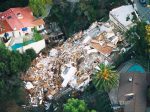
AN ROI PERSPECTIVE ON EARTHQUAKE INSURANCE
If you have equity in your home, you have a valuable asset that is worth protecting, the question: is how much is that protection worth? Whether or not the inevitable earthquake hits, if you have equity in your home, earthquake insurance makes sense.
Let’s say you have paid off your home in California, meaning you have an asset worth $750k. That asset is likely appreciating over time, so at a conservative 2% annual appreciation, it gains $15,000 in value per year.
For Californians who have owned their homes for 30 years or so, they are living in this home effectively rent-free (property taxes for long-term owners may be $3,000-$4,000 per year). Consider the loss of this home due to earthquake: that small annual property tax payment would be replaced by rent of 10x to 20x that amount – a difficult prospect for anyone, but particularly for those on a fixed income.
When added together, the appreciation and avoided rent combine for an annual benefit that is well over $60,000.
In the highest risk earthquake zones (Palm Desert or the San Francisco Bay Area, for example), you can generally purchase insurance coverage for under $2,000 per year. That $2,000 expenditure is about 3% of the property’s annual benefit, and less than 0.3% of its present value – and it protects the $750,000 of built up equity as well as the annual benefits it provides.
Even if that home “only” has $200,000-$300,000 of equity (which, in California, many have built up simply through appreciation over the past 5-10 years), earthquake insurance is still the smart move.
The only way a Californian loses all their hard work and equity in their largest asset is by not purchasing earthquake insurance. While saving the modest cost of annual premiums, an owner is putting a very valuable asset at risk of total loss.
The likelihood of a major earthquake striking California in the coming decades is significant, bordering on inevitable. According to U.S. Geological Survey (2015 UCERF3 Report), there is a 94% chance that an earthquake of at least 6.7 magnitude will occur in Southern California in the next 25 years, and a 95% chance that one strikes Northern California over the same timeframe. If you focus on just the most developed metropolitan areas, the likelihood is still very high: the Los Angeles region has a 60% chance of a 6.7 or greater earthquake, and the Bay Area has a 72% chance.
(In an interesting piece of structural hypocrisy, if your home has a greater than 25% chance of a flood over a 30-year timeframe, flood insurance is mandatory. Earthquake insurance, despite the above probabilities, remains optional.)
An additional risk factor for homeowners is the outsized growth of condos as a percentage of total the housing stock, as condos and other multifamily residential structures are far more vulnerable to earthquake damage. Over the last 25 years, the number of Californians living in multifamily housing has more than doubled, rising from 2.6 million units in 1994 to 5.4 million units today.
In 1994, the Northridge earthquake devastated the San Fernando Valley, causing roughly $20 billion in damage to residential structures alone. Detached homes fared much better than multifamily structures. Although multifamily dwellings accounted for only 22% of the area’s housing, they represented 84% of the damaged properties and nearly 72% of the “red-tagged” homes (homes that were too dangerous to inhabit). With the increase in condos as a percentage of homes, the number of homeowners at risk has gone up as well.
Professional investors regularly protect themselves against “black swan” events – extreme but unlikely events – through financial hedges. Earthquake insurance, by contrast, is effectively a hedge on an extreme, likely event. The only way to lose money in an earthquake is by not having earthquake insurance.
EXCLUSIONS and SUBLIMTS
The biggest exclusions to look out when considering earthquake insurance are for are damage to foundations, underground pipes and detached/underground garages (other common but less significant exclusions include bridges, paved surfaces and fences). For those living in any sort of Common Interest Development (condos, townhouses, co-ops, etc.), damage to common areas like a clubhouse or pool is frequently excluded from condo policies, so that should always be examined carefully. Earthquake products do exist that will cover these important exposures.
Personal Property Coverage also comes with several notable exceptions and sublimits that owners should be aware of:
- Glassware and other “breakables” are generally excluded
- Anything that can’t be commercially replaced – like fine art – is excluded as well
- Sublimits for certain classes of goods are standard (for example, most policies include a $1,000 sublimit on computers and other data processing equipment – meaning the most you can recover for lost computers is $1,000, no matter how much personal property coverage you purchase)
- Your personal insurance broker can help with specialized coverage for items that standard personal property coverage is not designed to protect
MISCONCEPTIONS
“The government will provide assistance, so I don’t need Insurance”
Many owners think the Federal Government will step in to provide assistance after a disaster. To put it simply: the US Government will not step in to save the equity in your home. Funds distributed through the Federal Emergency Management Administration (loans or grants) are only for health and safety. After past earthquakes, FEMA has capped individual assistance at $5,000, however that figure has increased to $33,000 after recent flood and windstorm events. Even at this higher level, government assistance will help an owner find alternative housing or take proactive steps to stop further damage, but it won’t rebuild a lost home, and in most cases, must be paid back over time.
“The government will help insulate me from my mortgage lender”
California is a “lender-friendly” state, with judicial foreclosures being very rare (judicial foreclosures offer more protections for delinquent borrowers). After an earthquake, this lender friendly environment means lenders can foreclose on a homeowner relatively quickly. If there is a dip in market value after an earthquake, for example, lenders can claim that there is a break in loan-to-value terms. Earthquake insurance represents critical collateral that can protect your equity from your mortgage lender.
In short: homeowners need to be proactive and protect themselves and what is likely their most valuable asset by exploring earthquake insurance.
FINAL THOUGHTS
Your personal insurance agent should always be your first stop to better understand your options for protecting your home. However, if you live in an homeowners association (condo, townhouse, co-op, etc.) you will need to take the additional steps:
- Find out if your association has a master earthquake policy from your manager or board (less than 10% of associations have a master earthquake policy)
- If there is a master earthquake policy how much coverage is there and what it excludes
- With this information, a unit owner can make an informed decision about what earthquake they will need to supplement the master earthquake policy or fully insurance themselves in the absence of a master earthquake policy.
For more information, call Motus today at (833) MOTUS-IN / (833) 668-8746, or visit us at www.motusins.com.


